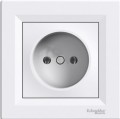Grounding
Sockets with grounding are intended for maintenance of industrial machinery and other equipment. The plug of equipment that requires grounding has an additional contact surface (grounding). Thanks to grounding, the socket protects the serviced equipment from short circuits and other power outages. To install models of this type, it is necessary that the electrical switchboard is equipped with a working ground terminal, and the power cable has an auxiliary conductor connected to ground in the switchboard.
Protective shutters
Protective shutters block free access to the electrocontact group. To use an outlet with curtains, the user must first remove the curtains themselves. Models of this type are mainly intended for installation in facilities where there are small children. Protective curtains prevent cases when a child sticks thin metal objects (hairpins, needles, knitting needles, etc.) into the plug holes.
Execution
— Horizontal. The design of the socket provides the installation of electrical accessories in a horizontal plane. Plug connectors are located one after the other, in a row, horizontally. The advantage of the horizontal arrangement of sockets is the possibility of convenient supply of plug connections. Plugs will not interfere with each other when simultaneously connected to adjacent connectors.
— Vertical. The vertical design of the sockets provides the location of the plugs one above the other. The vast majority of built-in vertical sockets have less than 2 plugs. The fact is that in vertical sockets for 3, 4 or more seats, it is inconvenient to simultaneously connect middle plugs if the plugs have an L-shaped profile. Overhead vertical sockets with plugs turned at an angle of 45˚ are widely used. Such models are devoid of the disadvantages of embedded analogues. The angular arrangement of the plugs allows you to simultaneously connect an unlimited number of L-shaped plugs.
Embedding depth
The insertion depth of the socket must correspond to the depth of the mounting box. Usually, the standard installation depth is 40 mm. But there are models with both smaller and larger installation depths. For example, narrow sockets require only 25 mm depth from the back box. Additionally, there is a series of sockets that require at least 60 or even 80 mm depth from the mounting box.
Frame thickness
This parameter is applicable to built-in electrical fittings. The thickness of the frame determines how much the outlet will protrude from the wall. In the average model, this figure is in the range of 7-10 mm. The thinner the frame, the more neat the socket will look.

